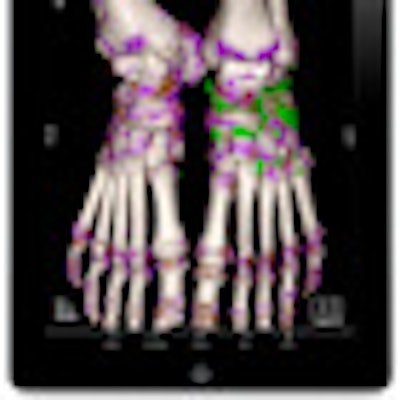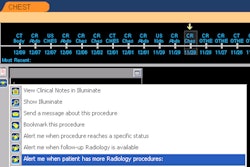
VIENNA - Over the past decade, PACS has become a vital component in the radiologist's toolbox, but looking beyond the doors of the radiology department, it's often a very different story. Therefore, PACS vendors are working hard to create technologies that allow images to be available hospital-wide, as well as trying to integrate into the electronic archive all relevant documentation needed to support decisions on patient care.
Managers at Carestream think they have taken a major step toward achieving this goal with the release of Vue Motion. This was on display at the 2011 European Congress of Radiology (ECR) as a work-in-progress, but it now appears for the first time as a commercial product. It is reportedly a zero footprint Web-based offering that means radiologists are no longer tied to their workstations. They can access images and reports on an Apple iPad or similar tablet computer, as well as on BlackBerrys, iPhones, and other handheld devices with Web capabilities, explained Saskia Groeneveld, European marketing manager for healthcare IT at Carestream.
In view of the size of any images displayed on a handheld device, the market authorization does not cover diagnostic use, but these novel technologies do allow radiologists to review previous images and contribute to multidisciplinary case conferences, irrespective of their geographical location.
 Image of patient with gout is displayed with syngo.via WebViewer. (Provided by Siemens)
Image of patient with gout is displayed with syngo.via WebViewer. (Provided by Siemens)
Vue Motion supports the display of clinical data from single or multiple users, providing the referring physician with a single point of access to the entire patient file, including a full report history and relevant prior exams and supporting data, according to Carestream. It is also flexible enough to cope with data encoded in a wide range of technical formats, including HL7, DICOM, and XDS but also non-DICOM image data such as PDF, JPEG, AVI, etc. It also encourages rapid informal responses because it is supports "sticky notes communication," including notification of critical results. With a single click, a physician can send a link to an examination inside an email to a professional colleague for a second opinion, for example.
Groeneveld notes that there is growing appreciation of the patient's ownership of their own medical data, and during ECR, the company is demonstrating (as a work-in-progress) a portal that allows patient access to their own electronic medical record.
"Ultimately, this will replace the cumbersome process in which data is sent on a CD through the post when a patient wants to seek a second opinion. It will also improve efficiency because there will be no need for the referral hospital to repeat the same radiological exams done at the first clinic. This will improve efficiency, reduce costs, and limit the radiation dose that the patient receives," she commented.
 Volume-rendered CT angiogram is displayed with syngo.via WebViewer. (Provided by Siemens)
Volume-rendered CT angiogram is displayed with syngo.via WebViewer. (Provided by Siemens)
Another leader in the development of improved interconnectivity tools is the California-based company, PACSGear. It will be demonstrating the first fruits of an ambitious program to redefine the scope of current PACS, which it is calling PACS 2.0.
"We are developing the technology that allows interactions with nonradiology devices, dermatology camera images, endoscopy videos, etc.," said Ton van den Hoven, vice president for sales and marketing with PACSGear. "We are facilitating the integration of those images into an electronic medical record or an existing PACS. There is a big demand from customers to start digitizing and integrating these kinds of images. They do not have access to the images at the moment, and so they have to go directly to the department where they were created to see them. The situation is like that which existed in a radiology department 15 to 20 years ago."
"Our company has grown because we have been able to bring nonscheduled information into the radiology PACS. Request forms, old films, and other data can now be included with the right contact details, patient information, and examination number, etc. This expertise allows other departments and others '-ologies' to make that quantum leap and bring necessary medical data into the electronic medical record. So other clinical departments can start benefiting from what radiology has done before," he pointed out.
At ECR, PACSGear is demonstrating applications such as MDR 7.0, an MPEG2/MPEG4-compliant video capture solution, and the PACSGear Media Server for video caching and streaming. Van de Hoven explained that the PACS 2.0 concept is intended to provide an array of different solutions to the same underlying connectivity problems. He estimates that about 75% of the relevant technology is already available. The rest will be developed through a series of development projects being undertaken with its customer hospitals.
"These projects are going on in different areas to prove the technology and further develop the workflow around it. Once you have got the information that you need and set it in the right context, the next step is working out exactly what else your customers want to do with that information," he stated.
Helping radiologists communicate better with hospital colleagues is also a theme being addressed on the Siemens Healthcare booth. The company is demonstrating the capabilities of the latest version of its syngo offering.
"Our new syngo.share application allows us to connect multiple hospital enterprises with each other and across '-ologies,' " noted Thorsten Koopmann, product manager for Siemens' healthcare IT business. "It gives DICOM and non-DICOM archive access to all the information that is available in a patient's electronic medical record through the one workspace. This is a huge step forward in connectivity and networking, even beyond the borders of the individual hospital."
At a time when radiologists are being asked to increase their productivity, the efficiency gains achievable through better communications are vitally important.
"This is an agile PACS designed to meet the demands of the clinical routine, allowing 2D, 3D, and 4D reading in one place when combined with the syngo.via technology," he remarked. "Through case-specific reading and a wide application range, we can support users in efficiently reading complex multimodality cases. It allows a smooth transition between different applications and helps speed up the reading workflow in small and large hospitals alike."
Syngo.via automatically preselects the information and workflow, and provides guidance on disease-specific requirements. Using syngo.via Mobile Applications, physicians and referrers within and outside the hospital can securely access images and reports for viewing in a standard Web browser or on a mobile device.
Improved productivity in the radiology department is also emphasized in Philips' latest offering in healthcare IT, the IntelliSpace PACS radiology 4.4. The product will help to support workflow efficiency with a customizable intuitive user interface and advanced workflow tools that reduce the steps required to view and interpret studies, noted Ian Catt, marketing manager for the company's Enterprise Imaging Informatics
 |
| IntelliSpace PACS Radiology 4.4 supports workflow efficiency with a customizable interface and advanced workflow tools designed to reduce the steps required to view and interpret studies. (Provided by Philips) |
"The IntelliSpace PACS is a fully functional workstation that includes 2D/3D/4D viewing tools for volumetric datasets. Customers are then able to purchase dedicated advanced clinical applications from an 'a la carte' menu of approximately 40 applications. These include CT Virtual Colonoscopy, CT Brain Perfusion, CT Lung Nodule Assessment, Nuclear Medicine viewer with PET/CT fusion, MR Cartilage Assessment ... just to name a few. All of these applications are available today with more being developed as we speak," he said.
Like its competitors, GE Healthcare has been examining the potential for developing interconnectivity solutions for mobile, Web-enabled devices, and the vendor has received approval for using its technology to view CT and MR images on a mobile device. The Centricity Radiology Mobile Access platform has been approved for primary diagnostic use in the U.S. on Apple's iPad, iPhone, and similar devices in situations when a PACS workstation is not available.
This application is one of many features being demonstrated in the ECR technical exhibition hall for the PACS Centricity system, which GE sees as a robust, reliable, and versatile technology. It offers a proven, scalable imaging IT platform designed to optimize radiologist productivity, enhance physician satisfaction, and interoperate with existing departmental (RIS, dictation) and enterprise systems, according to the company.
Originally published in ECR Today March 4, 2012.
Copyright © 2012 European Society of Radiology



















